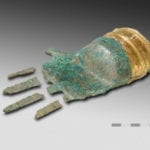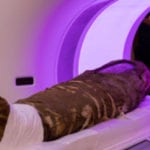 Weird Stuff
Weird Stuff  Weird Stuff
Weird Stuff  Mysteries
Mysteries 10 Tragic Disappearances and Deaths in Joshua Tree National Park
 History
History 10 Ways Childhood Really Sucked in the Old West
 Music
Music 10 Name Origins of Famous Bands from the 1990s
 Religion
Religion 10 Biggest Turnarounds by the Catholic Church
 Weird Stuff
Weird Stuff 10 Unbelievable Times Laws Had Unintended Consequences
 Humans
Humans Ten Historic Women Who Deserve Way More Credit Than They Got
 Movies and TV
Movies and TV 10 Films That Spawned Major Lawsuits
 History
History Ten Times Towns Were Wiped Off the Face of the Earth
 Creepy
Creepy 10 of the Most Disturbingly Haunted Public Houses in the UK
 Weird Stuff
Weird Stuff 10 Niche Subcultures That Are More Popular Than You Might Think
 Mysteries
Mysteries 10 Tragic Disappearances and Deaths in Joshua Tree National Park
 History
History 10 Ways Childhood Really Sucked in the Old West
Who's Behind Listverse?

Jamie Frater
Head Editor
Jamie founded Listverse due to an insatiable desire to share fascinating, obscure, and bizarre facts. He has been a guest speaker on numerous national radio and television stations and is a five time published author.
More About Us Music
Music 10 Name Origins of Famous Bands from the 1990s
 Religion
Religion 10 Biggest Turnarounds by the Catholic Church
 Weird Stuff
Weird Stuff 10 Unbelievable Times Laws Had Unintended Consequences
 Humans
Humans Ten Historic Women Who Deserve Way More Credit Than They Got
 Movies and TV
Movies and TV 10 Films That Spawned Major Lawsuits
 History
History Ten Times Towns Were Wiped Off the Face of the Earth
 Creepy
Creepy 10 of the Most Disturbingly Haunted Public Houses in the UK
Top 10 New Questions Surrounding London’s Biggest Mysteries
The city of London has been shrouded in mystery for centuries. From serial killers to mysterious disappearances to ghost sightings, some of London’s most famous enigmas are still talked about today. However, recent developments in science and technology have shed new light on the many unsolved crimes and riddles that have left experts stumped for decades—and sometimes even centuries. Still, as more details are uncovered, even more questions follow . . .
10 What Really Caused The Great Plague?
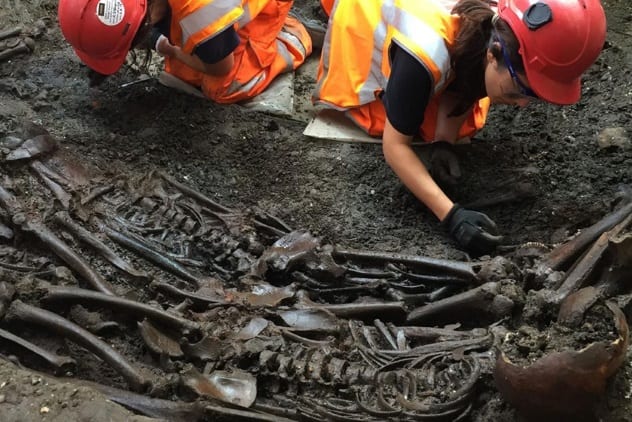
During the 1660s, the Great Plague of London killed more than a quarter of the city’s population in just 18 months. For centuries, experts believed that rats were responsible for the disease spreading so quickly, but recent DNA findings have shown that this isn’t the case at all.
In 2016, scientists from the Museum of London Archaeology and the Max Planck Institute in Germany examined 3,300 skeletons that were discovered in a burial ground near Liverpool Street.[1] During their studies, they found that DNA from the Yersinia pestis bacterium was present in 42 of the skeletons, and further analyses will reveal more about why it spread the way it did.
Researchers had already learned enough to refute the idea that the Great Fire of London was responsible for stopping the spread of the plague, as it was previously believed. Because the majority of the people dying from the plague were living in London’s suburbs around the time of the Great Fire in 1666, it could not have been a major cause of the disease being wiped out.
9 Was Walter Sickert Really Jack The Ripper?

Of all the greatest unsolved mysteries to come out of London, none are as well-known as that of Jack the Ripper, who terrorized the streets of East London during the late 1800s. As a matter of fact, the killer has become so infamous over the years that there is now a Jack the Ripper Museum in Whitechapel as well as a handful of tours to lead visitors around various Ripper-related crime scenes in East London.
German-born artist Walter Sickert has been accused of being Jack the Ripper by “ripperologists” since as far back as the 1970s. However, in recent years, author Patricia Cornwell has become so convinced of his guilt that she has written two books pinning Sickert to the murders. She even claims to have spent more than $7 million trying to solve the Ripper case.[2] In her new book, Cornwell claims that Sickert used to write letters on the exact same pack of 24-page stationery that matches a letter once penned by Jack the Ripper and that the letters even have matching watermarks.
She also claims that Sickert would dress up as Jack the Ripper whenever he created his paintings and that he once told a friend that “he would not mind having to kill and eat raw flesh.” Also, in her new book, she provides evidence that Sickert was in Britain during the time of at least three of the Ripper murders (although he had previously claimed to be in France) and even claims that Jack the Ripper’s death toll may have been at least four times higher than previously thought.
8 Is There Really A monster In The River Thames?
We’ve all heard of Nessie, the Loch Ness Monster, but could there be a similar sea monster roaming around London’s River Thames as well? In 2016, a tourist in London was riding the Emirates Air Line cable car near the O2 when he spotted something “fishy” in the water. He decided to pull out his phone and film what he saw. In the 30-second clip, viewers can see a mysterious dark mass with two humps emerging from the river’s surface. To add even more mystery to the sighting, the day after the video was posted, another video was shared online showing a strange object near the Thames Barrier.[3]
Marine biologists say they have no explanation as to what the creature could possibly be—if it is a creature—although some suggest it could be a whale or a pod of porpoises. Over the years, more than 2,000 seals and 450 porpoises and dolphins have been spotted swimming in the River Thames. Still, Ian Tokelove of the London Wildlife Trust said that the organization is “not aware of anything that large and moving in the Thames,” leaving the door open for further speculation.
7 Why Was A Walrus Buried At St Pancras?

Experts have been stumped ever since the remains of a 4-meter-long (13 ft) walrus were discovered underneath St Pancras Church in 2003. The nine bone fragments were found inside a coffin along with eight other human remains and three skulls, all of which were placed there sometime between 1822 and 1854.
In recent years, researchers came to the conclusion that the remains may have been used for medical science by one of the 40 different anatomy schools in London that were operating during the 19th century.[4] This is backed by the fact that just like the human remains, the walrus’s remains showed signs of dissection, with the bones and skulls all having holes drilled in them. Others believe that the walrus may have been brought to the UK for trade purposes, as its ivory tusks were considered incredibly valuable at that time. However, no one can pinpoint exactly why, or how, the walrus came to the UK in the first place.
This isn’t the only puzzling discovery of animal remains in a London grave. During a recent excavation at the Royal London Hospital, various animal parts, including the remains of a rabbit, cat, dog, horse, tortoise, and even two monkeys, were discovered alongside the many buried human remains found underneath the hospital.
6 Was Richard III Wrongfully Accused Of Murdering The Princes In The Tower?
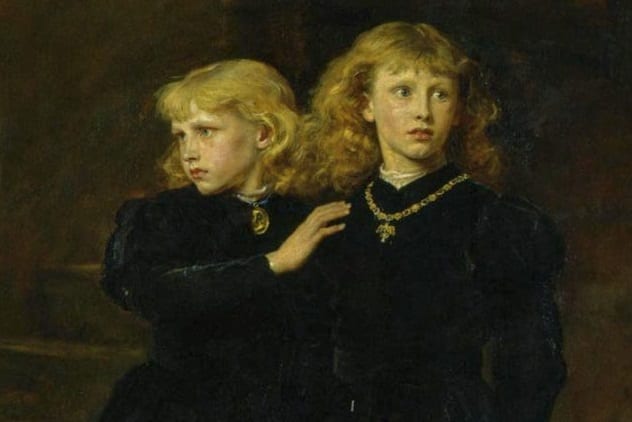
It was discussed in Shakespeare and even hinted at in recent seasons of Game of Thrones, but did Richard III really kill his nephews in order to secure his own place on the English throne? Experts think not.
The disappearance of Prince Edward and Prince Richard, often referred to as “the Princes in the Tower,” has befuddled historians for centuries. After two skeletons were discovered in the Tower of London in 1674, many were convinced that the bodies were those of the two princes, so much so that the remains were even placed inside an urn at Westminster Abbey. Everything changed when Richard III’s body was discovered underneath a car park in Leicester in 2012.[5] After a series of tests on the skull, it was discovered that Richard III had no genetic link to the remains discovered in the Tower.
Some believe that the remains may have been of Anglo-Saxon origin, but because the Church of England and the queen have turned down requests made by the Richard III Society to examine the remains, nothing can be proven either way. Furthermore, some claim that Richard III couldn’t have been guilty of the crime, as he never publicized the princes’ deaths or displayed their bodies in public.
5 Has Winston Churchill’s Ghost Been Spotted In The London Underground?
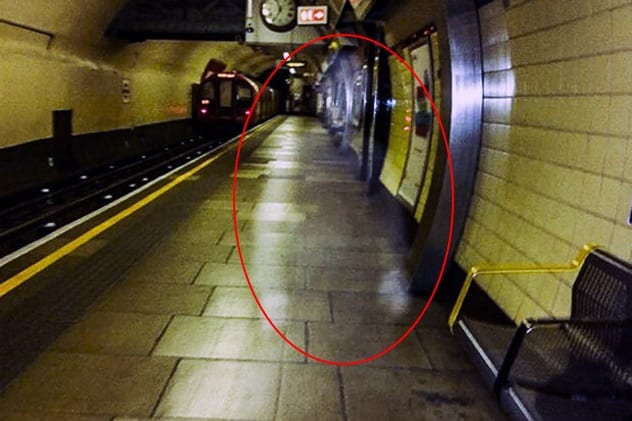
Reports of ghostly sightings of former British prime minister Winston Churchill at various tube stations in London have been floating around since the 1980s, but a recent photograph has added more fuel to the fire.[6]
In 2016, a Welsh tourist named Craig Cooper snapped a photo of a strange ghostly figure which was standing behind him at the Queensway station. Because the bald apparition in the photograph looks so much like Churchill, some have claimed that it is the ghost of the wartime leader himself.
4 Is There Really A Vampire At Highgate Cemetery?

Reports of a supposed “Highgate Vampire” have terrified North Londoners since the 1970s, but recent sightings have suggested that the vampire may have returned to Highgate Cemetery.
Witnesses have been reporting sightings of a “floating man” in Victorian clothing and a top hat floating through the cemetery’s locked gates over the past few decades, although David Farrant, who currently runs the British Psychic and Occult Society, was the first to spot the supposed vampire in 1969. Oddly enough, the charred, headless body of a woman was discovered nearby the following year.
In 2016, a man claimed to have seen the vampire silently gliding through a locked gate in 1991 when he was on his way to work. The man, Declan Walsh, claimed the figure was over 183 centimters (6′) in height and was wearing a long, black coat and a top hat. Some legends state that the vampire is a medieval nobleman who once practiced black magic in Romania, and after his body was brought to England in a coffin sometime during the 18th century, his spirit was awoken by modern-day Satanists visiting the cemetery.[7]
3 What Really Happened To Lord Lucan?

During the 1970s, the mystery surrounding the disappearance of Lord Lucan, as well as the death of his supposed victim, was huge news in the streets of London. After being accused of killing his children’s nanny and attacking his own wife, Lord Lucan (aka Richard John Bingham, 7th Earl of Lucan) seemed to disappear off the face of the Earth, and not much was known about where he disappeared to—until now.
Novelist Peter James has recently suggested that Lord Lucan’s aristocratic circle of gambling friends (known as the Clermont Set) helped him escape England in a “light plane” to Montreux, Switzerland.[8] However, after Lucan began talking about how he wanted to contact his children to let them know he was alright, the group was spooked and had him killed “Mafia-style.” His body is believed to have been buried in Switzerland out of fear that the group’s involvement in Lucan’s escape would be revealed.
In recent years, some have even suggested that Lucan was in fact innocent of the murder. However, this fact continues to be disputed.
2 What Were Anne Boleyn’s Last Words Before She Was Executed?
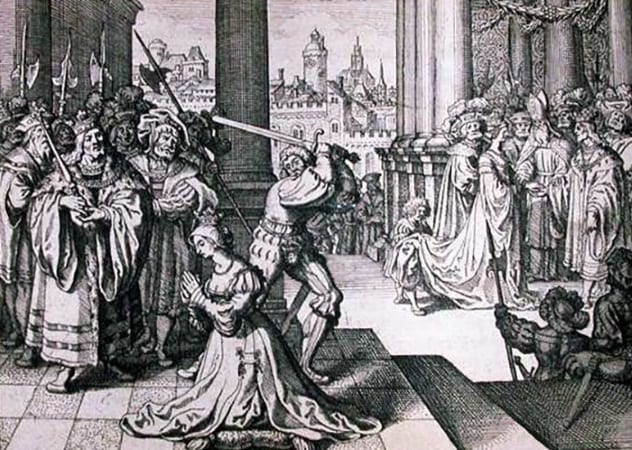
She’s been painted as everything from a seductive, conniving manipulator to a loving mother and wife—and this confusion extends even to her last words. Anne Boleyn, the second wife of Henry VIII and the mother of Queen Elizabeth I, was executed and beheaded at the Tower of London for high treason, adultery, and incest in 1536. Over the years, there have been varying reports of what Anne Boleyn said the moment before she died, which have left historians scratching their head for centuries.[9]
Some claimed her last words were, “I have not come here to preach a sermon; I have come here to die.” Others stated that she denied the charges against her, saying, “Everything they have accused me of is false, and the principle reason I am to die is Jane Seymour.” Still others asserted that she said, “Be not sorry to see me die like this.” Some witnesses to the execution even recounted that her lips continued moving for several seconds after she was beheaded!
1 Who Was Jack The Stripper?

We’ve all heard about Jack the Ripper, so for the residents of London’s Hammersmith district, Jack the Stripper’s 1964–1965 killing spree felt all too familiar. Often referred to as “the most infamous serial killer you’ve never heard of,” Jack the Stripper was believed to have killed several prostitutes during his lifetime. Although the official victim count is around six, some believe that he killed up to eight women in total.[10]
All of the Stripper’s victims were female prostitutes, and their bodies were discovered naked and strangled with their teeth knocked out, which has led experts to believe that the killer may have kept them as souvenirs. One of the victims (30-year-old Hannah Tailford) was discovered with her underwear stuffed in her mouth, while some of his other victims were found with small specks of paint on their bodies.
Nearly 120,000 people were interviewed and 26 suspects identified by police, but the killer’s identity remains a conundrum to this day. Some have suggested that the murderer may have been a former Metropolitan Police officer, while others have put the blame squarely on Mungo Ireland, a security guard who committed suicide in 1965. His body was discovered next to a note that said, “I cannot stand the strain any longer.” What he meant by that, we may never know.
Joe Wareham is a digital nomad and the founder of the travel blog Worlds Away: http://worldsaway.org/

